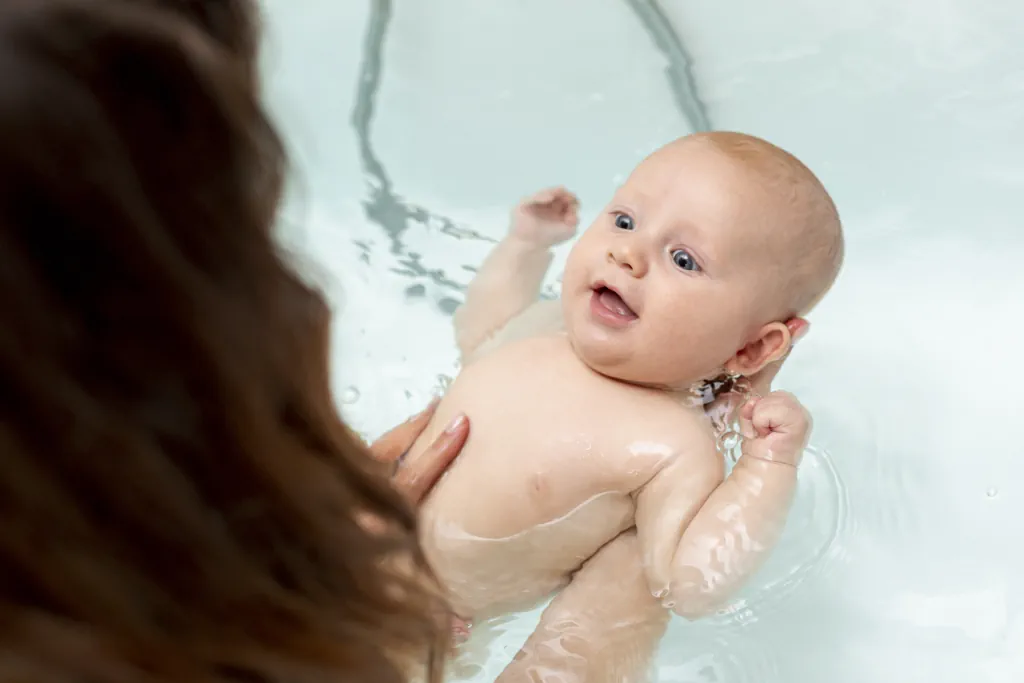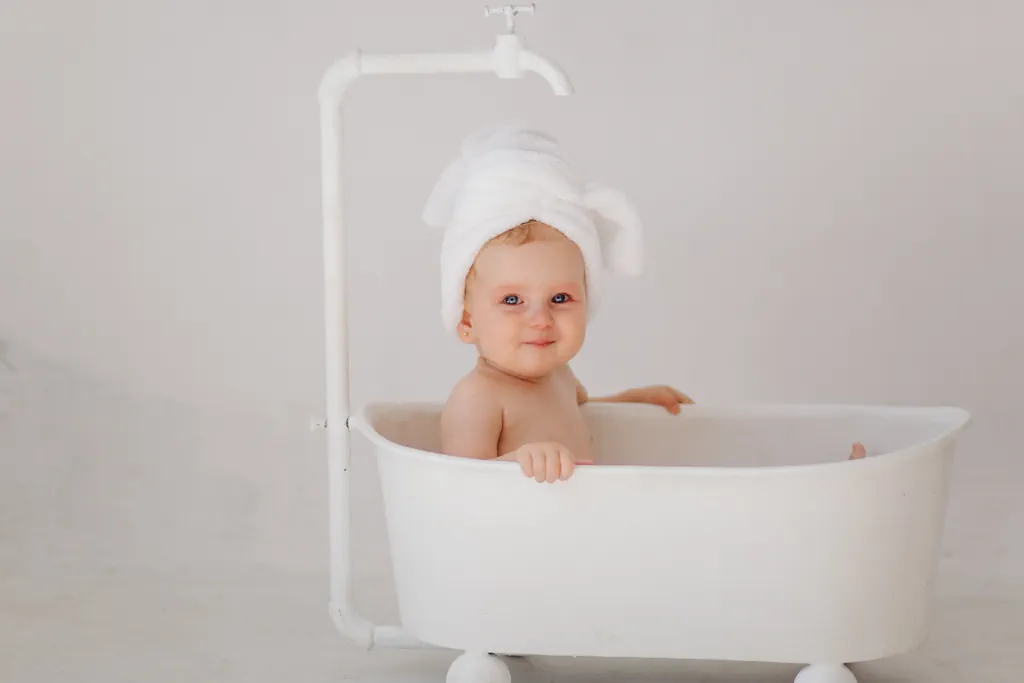Why Baby Bathing Matters
Bathing your baby is more than just a hygiene routine—it’s an opportunity for bonding, sensory stimulation, and relaxation. For newborns and infants, bath time can be calming and beneficial when done correctly. Regular bathing supports healthy skin, prevents rashes, and helps babies sleep better. In this guide, we’ll cover everything you need to know about baby baths in 2025, from choosing the right tub to creating a safe and enjoyable experience for your little one.

When Can You Start Bathing a Newborn?
Newborns typically receive their first sponge bath soon after birth, but you should wait until the umbilical cord stump falls off—usually within the first 1–2 weeks—before giving a full bath. Until then, sponge baths with warm water and a soft cloth are sufficient. Once the cord stump heals, you can introduce shallow water baths using a baby tub. Always consult your pediatrician if you’re unsure when to begin full bathing. Be gentle during early baths, keeping your baby warm, supported, and secure.
Choosing the Right Baby Bathtub
The ideal baby bathtub should be safe, ergonomic, and age-appropriate. Popular types include sink inserts (great for newborns), convertible tubs that grow with your child, and foldable options for small spaces. Key safety features to look for include non-slip surfaces, contoured support, and a water temperature indicator. Models like the Angelcare Baby Bath Support or Fisher-Price 4-in-1 Sling Tub are parent favorites. Ensure the tub is easy to clean and made of BPA-free, non-toxic materials. Investing in a quality tub enhances both comfort and safety.
Step-by-Step: How to Bathe a Baby Safely
Start by gathering all bath essentials: a towel, baby soap, washcloth, clean clothes, and a clean diaper. Fill the tub with about 2–3 inches of warm water (37–38°C or 98.6–100.4°F). Test the temperature with your elbow or a bath thermometer. Gently lower your baby into the water, supporting their head and neck. Wash their face with a damp cloth (no soap), then use baby-safe soap on their body and hair. Rinse thoroughly and dry immediately with a hooded towel. Bath time should last 5–10 minutes and always be supervised.

Baby Bath Essentials Checklist
To ensure a smooth bath routine, prepare the following items:
- Soft washcloths and towels with hoods
- Baby-safe shampoo and body wash
- Gentle hairbrush
- Rinsing cup or sprayer
- Baby lotion or moisturizer
- A clean diaper and outfit
- Thermometer to check water temperature
- A non-slip mat for added safety Having everything within reach prevents interruptions and keeps your baby safe and comfortable during bath time.
Tips for a Stress-Free Baby Bath Routine
Consistency and preparation are key to an enjoyable bath experience. Choose a time when your baby is calm, such as before bedtime. Keep the room warm and play soft music or speak soothingly to your baby. Lay out clothes and towels ahead of time. Never leave your baby unattended—not even for a second. Use positive reinforcement, like smiles and cuddles, to build a happy association with bath time. Over time, your baby will learn to love this routine, and it will become a special bonding moment for both of you.
Common Mistakes to Avoid During Baby Bath Time
Many new parents make well-intentioned mistakes during baby bath time. Avoid using too much soap, which can dry out delicate skin. Don’t bathe your baby in cold or overly hot water—always check the temperature first. Never leave your baby unattended in or near water. Don’t forget to clean skin folds, especially around the neck, behind the ears, and under the arms. Lastly, avoid daily baths in the first few months, as newborn skin can be sensitive and easily irritated by frequent washing.
How Often Should You Bathe Your Baby?
For newborns, 2–3 baths per week are generally sufficient unless there are diaper blowouts or spit-ups. As your baby becomes more mobile (around 6 months), more frequent bathing may be necessary. Daily baths are safe for older babies but should be quick and gentle. Always follow up with a fragrance-free baby moisturizer to prevent dryness. Tailor the frequency to your baby’s skin type and lifestyle, and consult your pediatrician if you notice dryness, rashes, or eczema flare-ups.
Natural and Organic Baby Bath Products
Parents today are more aware of what goes on their baby’s skin. Natural and organic bath products are made without synthetic fragrances, parabens, phthalates, or sulfates. Ingredients like aloe vera, chamomile, and calendula are gentle and effective. Trusted brands include Earth Mama, Mustela, and Aveeno Baby. When selecting products, look for third-party certifications and always patch test before full use. Organic options may be slightly pricier but provide peace of mind for health-conscious families.
FAQs About Baby Bathing
Q: Can I bathe my baby every day?
A: Daily baths are fine for older babies but not necessary for newborns. 2–3 times a week is usually enough.
Q: What if my baby cries during bath time?
A: Try adjusting the water temperature, room lighting, or bath time routine. Some babies cry due to overstimulation.
Q: When can I start using shampoo and soap?
A: Use gentle, tear-free products after the first couple of weeks. Start with small amounts and rinse well.
Q: Can I bathe my baby after feeding?
A: It’s best to wait 30–45 minutes after feeding to avoid spit-ups or discomfort.
Q: Is it safe to bathe my baby in a sink?
A: Yes, if the sink is clean and you’re using a proper insert or support designed for babies.
Conclusion: Building a Calm, Safe, and Joyful Bath Routine
Bathing your baby is a rewarding experience that fosters trust, relaxation, and developmental support. With the right preparation, tools, and techniques, bath time can become one of the most enjoyable parts of your day. Focus on creating a calm environment, using safe and gentle products, and engaging with your baby through eye contact and touch. As your confidence grows, so will your baby’s comfort and joy in the water. Let every splash be a step toward stronger bonding and a cleaner, happier baby.
Read also the article: How to Properly Bathe a Baby: Essential Safety and Care Tips for New Parents and Best Baby Strollers for Newborns in 2025: Safe, Stylish & Parent-Approved Picks and Best Diapers for Newborns in 2025 and Breastfeeding in 2025: Tips for a Successful Start and Best Baby Toys for 6 Month Olds in 2025: Top Picks
Note: This article is for informational purposes only and is not a substitute for professional advice. While every effort has been made to ensure that the content is accurate and useful, the portal does not guarantee the complete accuracy of all information. For specific cases and personalized solutions, we recommend consulting with a licensed professional in the relevant field.
